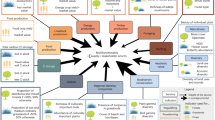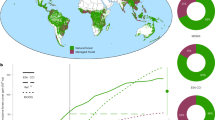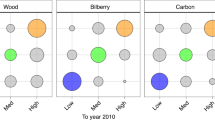Abstract
Decisions about natural resource management are frequently complex and vexed, often leading to public policy compromises. Discord between environmental and economic metrics creates problems in assessing trade-offs between different current or potential resource uses. Ecosystem accounts, which quantify ecosystems and their benefits for human well-being consistent with national economic accounts, provide exciting opportunities to contribute significantly to the policy process. We advanced the application of ecosystem accounts in a regional case study by explicitly and spatially linking impacts of human and natural activities on ecosystem assets and services to their associated industries. This demonstrated contributions of ecosystems beyond the traditional national accounts. Our results revealed that native forests would provide greater benefits from their ecosystem services of carbon sequestration, water yield, habitat provisioning and recreational amenity if harvesting for timber production ceased, thus allowing forests to continue growing to older ages.
This is a preview of subscription content, access via your institution
Access options
Access Nature and 54 other Nature Portfolio journals
Get Nature+, our best-value online-access subscription
$29.99 / 30 days
cancel any time
Subscribe to this journal
Receive 12 digital issues and online access to articles
$119.00 per year
only $9.92 per issue
Buy this article
- Purchase on Springer Link
- Instant access to full article PDF
Prices may be subject to local taxes which are calculated during checkout





Similar content being viewed by others
References
Oreskes, N. & Conway, E. M. Merchants of Doubt (Bloomsbury Press, New York, 2010).
Pielke, R. S. The Honest Broker: Making Sense of Science in Policy and Politics (Cambridge Univ. Press, Cambridge, 2007).
Saner, M. A. & Bordt, M. Building the consensus: the moral space of earth measurement. Ecol. Econ. 130, 74–81 (2016).
Sustainable Development Goals (United Nations, 2015); http://www.un.org/sustainabledevelopment/sustainable-development-goals/.
System of Environmental–Economic Accounting 2012: Central Framework (United Nations, 2014); http://unstats.un.org/unsd/envaccounting/seeaRev/SEEA_CF_Final_en.pdf.
System of Environmental–Economic Accounting 2012: Experimental Ecosystem Accounting (United Nations, 2014); http://unstats.un.org/unsd/envaccounting/seeaRev/eea_final_en.pdf.
System of National Accounts 2008 (United Nations, 2009); https://unstats.un.org/unsd/nationalaccount/docs/SNA2008.pdf.
Repetto, R. Wasting assets: the need for national resource accounting. Tech. Rev. 93, 38–45 (1990).
Ouyang, Z. et al. Improvements in ecosystems services from investments in natural capital. Science 352, 1455–1459 (2016).
Vardon, M., Burnett, P. & Dovers, S. The accounting push and pull: balancing environment and economic decisions. Ecol. Econ. 124, 145–155 (2016).
Ruckelshaus, M. et al. Notes from the field: lessons learned from using ecosystem service approaches to inform real-world decisions. Ecol. Econ. 115, 11–21 (2015).
De Groot, R. S., Alkemade, R., Braat, L., Hein, L. & Willemen, L. Challenges in integrating the concept of ecosystem services and values in landscape planning, management and decision making. Ecol. Complex. 7, 260–272 (2010).
Costanza, R. et al. The value of the world’s ecosystem services and natural capital. Nature 387, 253–260 (1997).
Daily, G. C. et al. Ecosystem services in decision making: time to deliver. Ecosys. Serv. 7, 21–28 (2009).
Ma, S. et al. Valuation of ecosystem services to inform management of multiple-use landscapes. Ecosys. Serv. 19, 6–18 (2016).
Bateman, I. et al. Bringing ecosystem services into economic decision-making: land use in the United Kingdom. Science 341, 45–50 (2013).
Obst, C., Edens, B. & Hein, L. Ecosystem services: accounting standards. Science 342, 420 (2013).
Fisher, B., Turner, R. K. & Morling, P. Defining and classifying ecosystem services for decision making. Ecol. Econom. 68, 643–653 (2009).
European Environment Agency CICES: Towards a Common Classification of Ecosystem Services (Common International Classification of Ecosystem Services, 2016); http://www.cices.eu.
Lindenmayer, D. B. et al. Interacting factors driving a major loss of large trees with cavities in a forest ecosystem. PLoS ONE 7, e41864 (2012).
Great Forest National Park: Economic Contribution of Park Establishment, Park Management, and Visitor Expenditure (Nous Group, 2017); http://www.greatforestnationalpark.com.au/uploads/1/5/5/7/15574924/nous_gfnp_economic_contribution_study_3_february_2017.pdf.
Jakobsson, K. M. & Dragun, A. K. The worth of a possum: valuing species with the contingent valuation method. Environ. Res. Econ. 19, 211–227 (2001).
Vira, B. & Adams, W. M. Ecosystem services and conservation strategy: beware the silver bullet. Conserv. Lett. 2, 158–162 (2009).
Chee, Y. E. An ecological perspective on the valuation of ecosystem services. Biol. Conserv. 120, 549–565 (2004).
Van Oudenhoven, A. P. E., Petz, K., Alkemande, R., Hein, L. & de Groot, R. S. Framework for systematic indicator selection to assess effects of land management on ecosystem services. Ecol. Indicators 21, 110–122 (2012).
Lindenmayer, D. B. et al. An empirical assessment and comparison of species-based and habitat-based surrogates: a case study of forest vertebrates and large old trees. PLoS ONE 9, e89807 (2014).
Ajani, J., Keith, H., Blakers, M., Mackey, B. G. & King, H. P. Comprehensive carbon stock and flow accounting: a national framework to support climate change mitigation policy. Ecol. Econ. 89, 61–72 (2013).
Mackey, B. et al. Untangling the confusion around land carbon science and climate change mitigation policy. Nat. Clim. Change 3, 552–557 (2013).
Obst, C., Hein, L. & Edens, B. National accounting and the valuation of ecosystem assets and their services. Environ. Res. Econ. 64, 1–23 (2016).
Castañeda, J. P., Obst, C., Varela, E., Barrios, J. M. & Narloch, U. Forest Accounting Sourcebook. Policy Applications and Basic Compilation. (World Bank, Washington, DC, 2017).
Tol, R. S. J. The marginal damage costs of carbon dioxide emissions: an assessment of the uncertainties. Energy Pol. 33, 2064–2074 (2005).
Valuing Climate Damages: Updating Estimation of the Social Cost of Carbon Dioxide (The National Academies of Sciences, Engineering and Medicine, 2017); https://www.nap.edu/catalog/24651/valuing-climate-damages-updating-estimation-of-the-social-cost-of.
Regional Forest Agreements (Australian Government Department of Agriculture and Water Resources, 2016); http://www.agriculture.gov.au/forestry/policies/rfa.
Viggers, J. L., Weaver, H. J. & Lindenmayer, D. B. Melbourne’s Water Catchments Perspectives on a World-Class Water Supply. (CSIRO Publishing, Collingwood, 2013).
Keith, H., Mackey, B. G. & Lindenmayer, D. B. Re-evaluation of forest biomass carbon stocks and lessons from the world’s most carbon-dense forests. Proc. Natl Acad. Sci. USA 106, 11635–11640 (2009).
Value of Tourism to Victoria’s Regions 2013–14 (Tourism Victoria, 2015); http://www.tourism.vic.gov.au/component/edocman/?view=documenttask=document.downloadid=941.
Victorian Land Use Information System 2014/2015 (Government of Victoria, 2015); https://www.data.vic.gov.au/data/dataset/victorian-land-use-information-system-2014-2015.
Guo, S., Wang, J., Xiong, L., Ying, A. & Li, D. A macro-scale and semi-distributed monthly water balance model to predict climate change impacts in China. J. Hydrol. 268, 1–15 (2002).
eMAST R-package 2.0 (TERN, 2016); http://www.emast.org.au/observations/bioclimate/.
Feikema, P. M. et al. Hydrolgical Studies into the Impact of Timber Harvesting on Water Yield in State Forests Supplying Water to Melbourne (eWater Cooperative Research Centre, Canberra, 2006).
Feikema, P. M., Sherwin, C. B. & Lane, P. N. J. Influence of climate, fire severity and forest mortality on predictions of long term streamflow: potential effect of the 2009 wildfire on Melbourne’s water supply catchments. J. Hydrol. 488, 1–16 (2013).
Vertessy, R. A., Watson, F. G. R. & O’Sullivan, S. K. Factors determining relations between stand age and catchment water balance in mountain ash forests. For. Ecol. Manage. 143, 13–26 (2001).
Kuczera, G. Prediction of Water Yield Reductions Following a Bushfire in Ash – Mixed Species Eucalypt Forest Report No. MMBW-W-0014 (Melbourne Metropolitan Board of Works, 1985).
Kuczera, G. Prediction of water yield reductions following a bushfire in ash-mixed species eucalypt forest. J. Hydrol. 94, 215–236 (1987).
Vertessy, R. A., Hatton, T. J., Benyon, R. G. & Dawes, W. R. Long-term growth and water balance predictions for a mountain ash (Eucalyptus regnans) forest catchment subject to clear-felling and regeneration. Tree Physiol. 16, 221–232 (1996).
Watson, F. G. R., Vertessy, R. A. & Grayson, R. B. Large-scale modelling of forest hydrological processes and their long-term effect on water yield. Hydrol. Proc. 13, 689–700 (1999a).
Watson, F., Vertessy, R., McMahon, T., Rhodes, B. & Watson, I. Improved methods to assess water yield changes from paired-catchment studies: application to the Maroondah catchments. For. Ecol. Manage. 143, 189–204 (2001).
Lane, P. N. J., Feikema, P. M., Sherwin, C. B., Peel, M. C. & Freebairn, A. C. Modelling the long term water yield impact of wildfire and other forest disturbance in Eucalypt forests. Environ. Mod. Soft. 25, 467–478 (2010).
Buckley, T. N., Turnbull, T. L., Pfautsch, S., Gharun, M. & Adams, M. A. Differences in water use between mature and post-fire regrowth stands of subalpine Eucalyptus delegatensis R. Baker. For. Ecol. Manage. 270, 1–10 (2012).
Keith, H., Mackey, B. G., Berry, S., Lindenmayer, D. B. & Gibbons, P. Estimating carbon carrying capacity in natural forest ecosystems across heterogeneous landscapes: addressing sources of error. Global Change Biol. 16, 2971–2989 (2010).
Land Sector Reporting: Full Carbon Accounting Model (FullCAM) (Australian Government Department of the Environment and Energy, 2015); https://www.environment.gov.au/climate-change/greenhouse-gas-measurement/land-sector.
Australian Bureau of Agricultural and Resource Economics and Sciences Australian Plantation Statistics 2016 (Australian Government Department of Agriculture and Water Resources, Canberra, 2016); http://data.daff.gov.au/data/warehouse/aplnsd9ablf002/aplnsd9ablf201608/AustPlantationStats_2016_v.1.0.0.pdf.
2016/17 Forest Management Plan (HVP Plantations, 2016); https://www.hvp.com.au/wp-content/uploads/2016/12/2016_17-HVP-FOREST-MANAGEMENT-PLAN.pdf.
Varcoe, T., O’Shea, H. B. & Contreras, Z. Valuing Victoria’s Parks: Accounting for Ecosystems and Valuing their Benefits: Report of the First Phase Findings (Parks Victoria & Department of Environment, Land, Water and Planning, Victorian Government, 2015).
Lindenmayer, D. B., Cunningham, R. B., Tanton, M. T., Smith, A. P. & Nix, H. A. Characteristics of hollow-bearing trees occupied by arboreal marsupials in the montane ash forests of the Central Highlands of Victoria, south-east Australia. For. Ecol. Manage. 40, 289–308 (1991).
Edens, B. & Graveland, C. Experimental valuation of Dutch water resources according to SNA and SEEA. Water Res. Econ. 7, 66–81 (2014).
2008 Waterways Water Plan (Melbourne Water, 2008); http://www.esc.vic.gov.au/wp-content/uploads/esc/64/64055944-d4cf-4a27-96c7-01e4bc27bcd8.pdf.
Auction – November 2015. Clean Energy Regulator (21 November, 2016); http://www.cleanenergyregulator.gov.au/ERF/Auctions-results/November-2015.
Corporate Reporting: Annual Reports 2007-2015 (VicForests, 2015); http://www.vicforests.com.au/our-organization/corporate-reporting-5.
5204.0 - Australian System of National Accounts, 2015-16. Table 58 Capital Stock by Industry and Table 65 Consumption of Fixed Capital by Industry by Type of Asset (Australian Bureau of Statistics, 2017); http://www.abs.gov.au/AUSSTATS/abs@.nsf/DetailsPage/5204.02015-16?OpenDocument. Disaggregated data for Subdivision 03 Forestry and Logging available on request from the Australian Bureau of Statistics.
Australian Environmental–Economic Accounts (Australian Bureau of Statistics, 2014); http://www.abs.gov.au/ausstats/abs@.nsf/mf/4655.0.
2010–11: Value of Principal Agricultural Commodities Produced: Australia, Preliminary (Australian Bureau of Statistics, 2011); http://www.ausstats.abs.gov.au/ausstats/subscriber.nsf/0/F6F20CFC59C07E0DCA25794A0011F935/$File/75010_2010_11.pdf.
Value of Agricultural Commodities Produced, Australia. (Australian Bureau of Statistics, 2016); http://www.abs.gov.au/ausstats/abs@.nsf/PrimaryMainFeatures/7503.0?OpenDocument.
An Experimental Ecosystem Account for the Great Barrier Reef Region, 2015 (Australian Bureau of Statistics, 2015); http://www.abs.gov.au/AUSSTATS%5Cabs@.nsf/0/FB46321B5BA1A8EACA257E2800174158?Opendocument.
Australian System of National Accounts (Australian Bureau of Statistics, 2016); (ABS Cat. No. 5204.0); http://www.abs.gov.au/AusStats/ABS@.nsf/MF/5204.0.
Annual Report Archive (Melbourne Water, 2000-2015); http://www.melbournewater.com.au/aboutus/reportsandpublications/Annual-Report/Pages/Annual-Report-archive.aspx.
Sequestration Decision Tree. Emissions Reduction Fund, Opportunities for the Land Sector (Clean Energy Regulator, (2016); http://www.cleanenergyregulator.gov.au/DocumentAssets/Documents/Sequestration%20decision%20tree%202016.pdf.
Annual Report 2013-2014 (Parks Victoria, State Government of Victoria); http://parkweb.vic.gov.au/about-us/publications-list/annual-reports.
Acknowledgements
Support for this project was provided by research funding from Fujitsu Laboratories, Japan, and the National Environmental Science Programme of the Australian Department of the Environment and Energy and is gratefully acknowledged. We thank staff at the Australian Bureau of Statistics, the Victorian Department of Environment, Land, Water and Planning, and VicForests for assistance with access to data and its interpretation. This research was undertaken with the assistance of resources from the Australian Government’s National Collaborative Research Infrastructure Strategy through its Terrestrial Ecosystem Research Network programme and the National Computational Infrastructure programme. We thank participants who attended a workshop in Melbourne in August 2016 for constructive feedback on the study, C. Hilliker for expert assistance with graphics and P. Burnett for helpful comments on a draft of the manuscript.
Author information
Authors and Affiliations
Contributions
H.K., M.V. and D.L. designed the study. H.K. and M.V. performed the calculations. J.A.S. performed the spatial analysis. J.L.S. performed the hydrological modelling. The manuscript was written by H.K. with contributions from M.V. and D.L.
Corresponding author
Ethics declarations
Competing interests
The authors declare no competing financial interests.
Additional information
Publisher’s note: Springer Nature remains neutral with regard to jurisdictional claims in published maps and institutional affiliations.
Electronic supplementary material
Supplementary Information
Supplementary Methods, Supplementary Figures 1–4, Supplementary Tables 1–3, Supplementary Glossary, Supplementary References
Rights and permissions
About this article
Cite this article
Keith, H., Vardon, M., Stein, J.A. et al. Ecosystem accounts define explicit and spatial trade-offs for managing natural resources. Nat Ecol Evol 1, 1683–1692 (2017). https://doi.org/10.1038/s41559-017-0309-1
Received:
Accepted:
Published:
Issue Date:
DOI: https://doi.org/10.1038/s41559-017-0309-1
This article is cited by
-
From COVID-19 to Green Recovery with natural capital accounting
Ambio (2023)
-
Why We Need to Invest in Large-Scale, Long-Term Monitoring Programs in Landscape Ecology and Conservation Biology
Current Landscape Ecology Reports (2022)
-
The interactions among fire, logging, and climate change have sprung a landscape trap in Victoria’s montane ash forests
Plant Ecology (2022)
-
Eight things you should never do in a monitoring program: an Australian perspective
Environmental Monitoring and Assessment (2022)
-
From natural capital accounting to natural capital banking
Nature Sustainability (2021)



